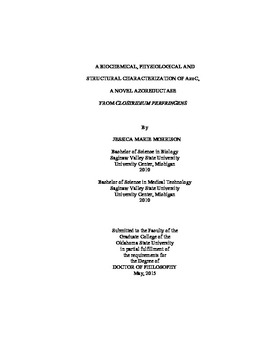| dc.contributor.advisor | John, Gilbert H. | |
| dc.contributor.author | Morrison, Jessica Marie | |
| dc.date.accessioned | 2016-04-15T21:49:30Z | |
| dc.date.available | 2016-04-15T21:49:30Z | |
| dc.date.issued | 2015-05 | |
| dc.identifier.uri | https://hdl.handle.net/11244/33435 | |
| dc.description.abstract | Azo dyes are used throughout the paper, textile, food, beverage, pharmaceutical and cosmetic industries as artificial colorants and are characterized by the presence of an azo (double nitrogen) bond. Azoreductases are bacterially-produced enzymes which are capable of breaking these azo bonds and, in some cases, can result in the production of carcinogenic metabolites. Clostridium perfringens, a common inhabitant of both the human gut and the environment, is a bacteria that produces a significant amount of azoreductase activity. The gene that encodes for this azoreductase was characterized and given the name AzoC. AzoC is very novel, as compared to similarly functioning enzymes. AzoC has been shown to preferentially reduce large molecular weight sulfonated azo dyes, such as Direct Blue 15 (992.8 g/mol), with use of NADH and FAD as cofactors. The azoreduction is much increased under anaerobic conditions as compared to aerobic conditions (4-fold greater activity under anaerobic conditions). Interestingly, with certain azo dye and cofactor conditions, the presence of the cofactors alone can cause azo dye reduction. However, with the use of an azoreductase-free control in place, this can non-enzymatic activity can be accounted for. In addition, the structure of AzoC was found to be trimeric in nature, with the AzoC monomers being held together by disulfide bonding. The secondary structure of AzoC is consistent with that of other azoreductases, despite having low sequence identity. When the azoC gene was disrupted (knocked out) by intron insertion, results suggested the presence of additional enzymes capable of azoreduction. In addition, azo dye metabolites produced following azo dye reduction were found to slow C. perfringens generation time. AzoC was found to be released following C. perfringens exposure to sulfonated azo dyes and negatively charged sulfonated compounds. This enzyme was also found to localize to the Gram-positive periplasmic region of the C. perfringens cells. The results of this study serve to fill an important gap in the literature, providing the first information on a strictly anaerobic azoreductase, as well as a link between environmental azo dye exposure and the physiological state of Clostridium perfringens cells. | |
| dc.format | application/pdf | |
| dc.language | en_US | |
| dc.rights | Copyright is held by the author who has granted the Oklahoma State University Library the non-exclusive right to share this material in its institutional repository. Contact Digital Library Services at lib-dls@okstate.edu or 405-744-9161 for the permission policy on the use, reproduction or distribution of this material. | |
| dc.title | Biochemical, physiological and structural characterization of AzoC, a novel azoreductase from Clostridium perfringens | |
| dc.contributor.committeeMember | Hoff, Wouter D. | |
| dc.contributor.committeeMember | Fathepure, Babu Z. | |
| dc.contributor.committeeMember | Lutter, Erika I. | |
| dc.contributor.committeeMember | Lucas, Edralin A. | |
| osu.filename | Morrison_okstate_0664D_13850.pdf | |
| osu.accesstype | Open Access | |
| dc.type.genre | Dissertation | |
| dc.type.material | Text | |
| thesis.degree.discipline | Microbiology, Cell and Molecular Biology | |
| thesis.degree.grantor | Oklahoma State University | |
